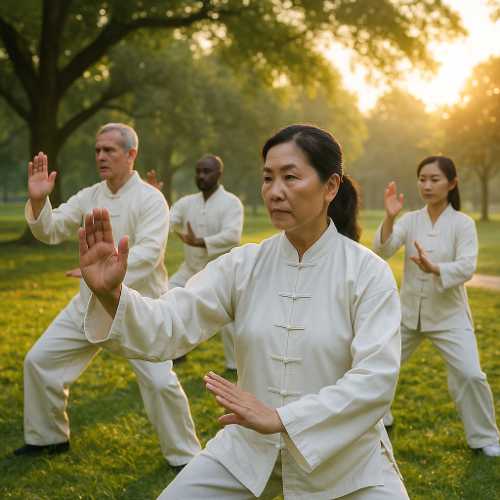Why Simple Taiji & Qigong Movements Work
To an untrained eye, the slow circular gestures of Taijiquan and the gentle stretches of Qigong may seem almost too simple to matter. In a world filled with high-intensity workouts and wearable fitness trackers, why would such quiet, unhurried movements hold so much power and health benefits? Yet those who practice regularly discover that behind this apparent simplicity lies a depth that nourishes both body and mind.
Did You Know?
Although Taiji and Qigong movements appear slow and gentle, research has shown measurable benefits:
- Improved balance and reduced fall risk in older adults
- Lowered blood pressure and enhanced circulation
- Reduced anxiety and stress through breath–body integration
- Strengthened immune response with regular practice
What looks simple on the surface is working on multiple levels—body, breath, and mind—all at once.
In Chinese tradition, stillness and subtlety often contain more strength than brute force. Taiji and Qigong draw from principles of Daoism and traditional Chinese medicine, where balance, circulation, and awareness are seen as essential for health. Each motion is designed not to push the body past its limits but to integrate breathing, posture, and intention into a unified whole. Instead of exhausting energy, these practices cultivate it, replenishing rather than depleting.
One reason these movements are so profound is the attention to alignment. By standing or moving in harmony with natural structure, practitioners release unnecessary tension and allow the body’s connective tissues, or fascia, to support movement more efficiently. Modern research increasingly shows that this web of fascia acts as an interconnected system, distributing forces through the body much like a tensegrity structure. The “frame” created in Taiji or Qigong practice offers stability and resilience, which explains why even gentle exercises can improve balance, flexibility, and strength in ways that last.
Equally important is the cultivation of intention. In Chinese thought, where the mind goes, energy follows. A simple shift of weight from one leg to another, when guided by focused attention and coordinated breath, awakens proprioception, the body’s sense of itself in space. Over time, this heightened awareness reduces stress, sharpens concentration, and nurtures a calmer emotional state. Western medicine has begun to document these effects, with studies showing reduced anxiety, better sleep, and improved immune function among regular practitioners.
Another layer of depth lies in the rhythm of breath. Each inhalation and exhalation guides the pace of movement, harmonizing the nervous system. Instead of treating exercise as a separate activity, Taiji and Qigong integrate breathing with posture and focus, creating a holistic state where physical, mental, and emotional health reinforce one another. It is not about “working out” but about “working in.”
Finally, the communal aspect cannot be overlooked. Practicing in parks or shared spaces brings people together across ages and backgrounds. The movements may look simple, but the sense of belonging and connection is profound. For many, this social dimension sustains the practice as much as the health benefits themselves.
What appears effortless is, in fact, deeply layered. Each step, each turn of the wrist, each coordinated breath is the result of centuries of refinement. Taiji and Qigong remind us that simplicity does not mean shallowness. Rather, the profound often reveals itself only when we slow down enough to feel it.







